Papaya has a medium glycemic index, making it a relatively better fruit choice for diabetics. The fruit’s fiber content and vitamins may offer additional health benefits. Diabetics should consider portion sizes and maintain a balanced diet.
Papayas, known for their vibrant color and sweet taste, have often raised questions about their suitability for people with diabetes. This stems from the need to manage blood sugar levels and adhere to dietary choices that support overall health. It’s important for diabetics to differentiate between natural sugars in fruits and added sugars found in processed foods, as the impact on blood glucose can vary significantly.
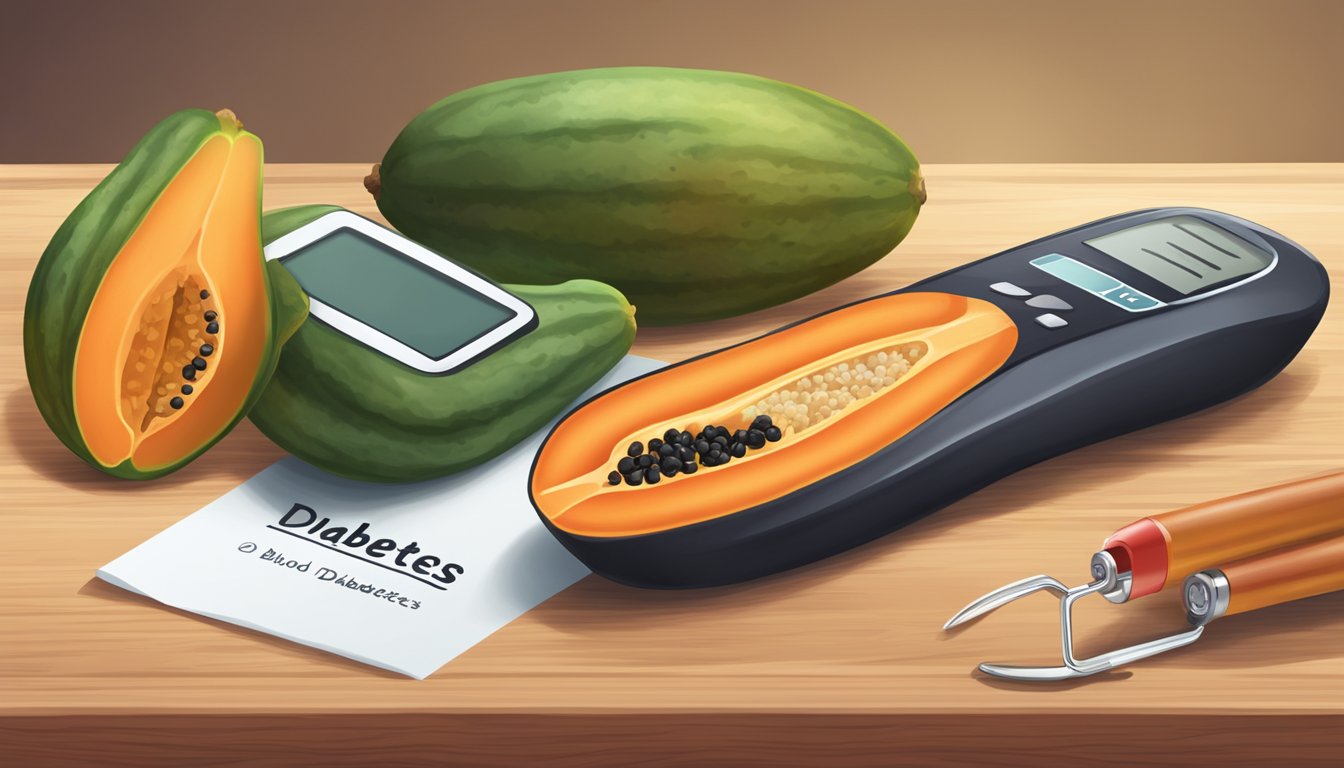
Research suggests that the glycemic index (GI) of papaya is medium, which means it doesn’t lead to rapid sugar level spikes. Coupled with its fiber content and an array of essential nutrients like vitamin C, potassium, and antioxidants, papaya might fit into a diabetic’s balanced diet quite well. However, portion size and overall balance of the meal are key considerations when incorporating papaya or any fruit into a diabetic diet.
How Does Diabetes Affect Blood Sugar Control?
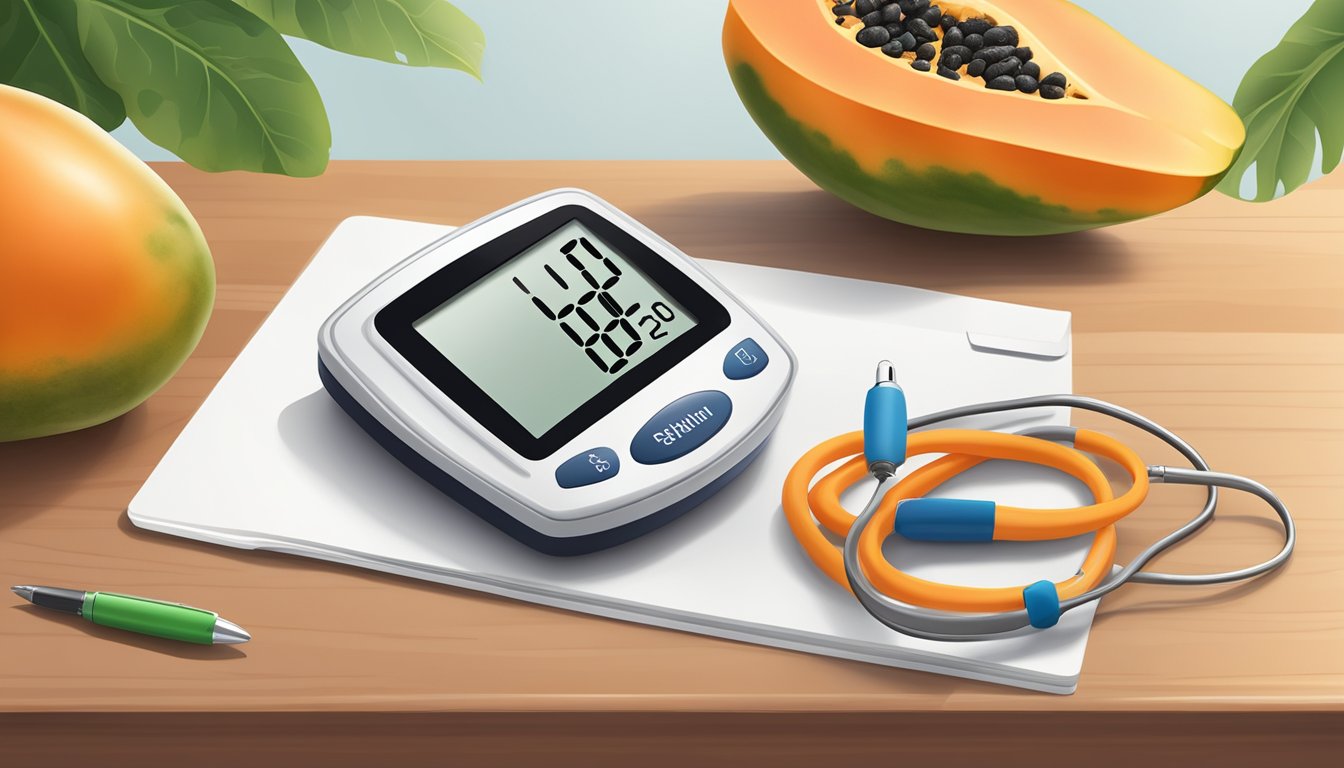
Diabetes affects the body’s ability to regulate blood sugar levels, making blood sugar control a critical aspect of diabetes management. This section outlines the importance of maintaining stable blood sugar levels and the measures involved in diabetes management.
How Can One Regulate Blood Sugar Levels?
Regulating blood sugar levels is crucial to prevent both short-term and long-term complications associated with diabetes. Individuals can regulate their blood sugar levels through:
- Diet: Consuming a balanced diet with an emphasis on low-glycemic index foods that do not cause significant blood sugar spikes.
- Exercise: Engaging in regular physical activity to help improve insulin sensitivity and lower blood sugar levels.
- Medication: Taking prescribed medications that help to either increase insulin production or improve its usage in the body.
What is Involved in Effective Diabetes Management?
Effective diabetes management requires a comprehensive approach that includes:
- Monitoring: Regularly checking blood sugar levels to ensure they remain within a target range.
- Education: Understanding how different foods and activities affect blood sugar levels.
- Planning: Organizing meals and activity schedules that align with blood sugar control goals.
| Strategy | Description |
|---|---|
| Dietary Choices | Incorporating fiber, managing carbohydrate intake. |
| Physical Activity | Consistent exercise routine tailored to individual capability. |
| Medication Adherence | Taking all medicines as prescribed by healthcare providers. |
Maintaining healthy blood sugar levels reduces the risk of high blood sugar (hyperglycemia) and low blood sugar (hypoglycemia), both of which can have immediate and long-term health implications for individuals with diabetes.
The Glycemic Index of Foods
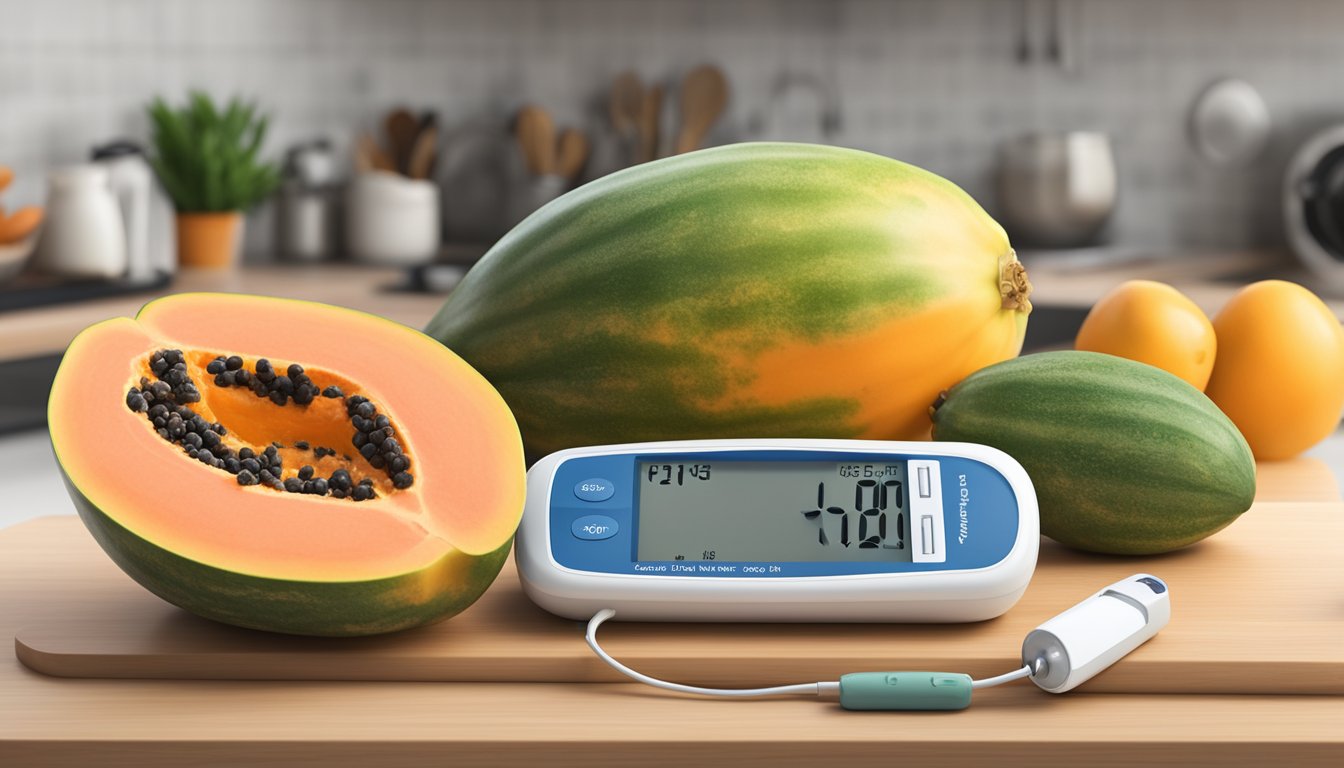
In understanding how food affects blood sugar, the glycemic index (GI) plays a critical role.
Is Papaya’s Glycemic Index Considered Safe for Diabetics?
Papaya has a moderate glycemic index. Typically, it scores around 60 on the GI scale, which categorizes it as a medium GI food.
- Low GI: Scores 20-49
- Medium GI: Scores 50-69
- High GI: Scores 70 and above
Papaya falls into the category where consumption should be moderate to avoid rapid increases in blood sugar levels.
How Do Fruits Generally Affect Blood Sugar Levels?
Fruits vary widely in their impact on blood sugar.
| Fruit | Glycemic Index | GI Category |
|---|---|---|
| Apple | 40 | Low |
| Papaya | 59 | Medium |
| Banana | Higher than 60 | Medium to High |
- Fruits with a low glycemic index (GI of 55 or less) are digested slowly and cause a lower and slower rise in blood sugar levels.
- Medium GI fruits can still be part of a diabetes-friendly diet, but portion sizes and overall balance must be considered.
- High GI fruits might lead to rapid spikes in blood sugar and should be eaten cautiously, especially for those managing diabetes.
Is Papaya Good for Diabetes in a Diabetic Diet?
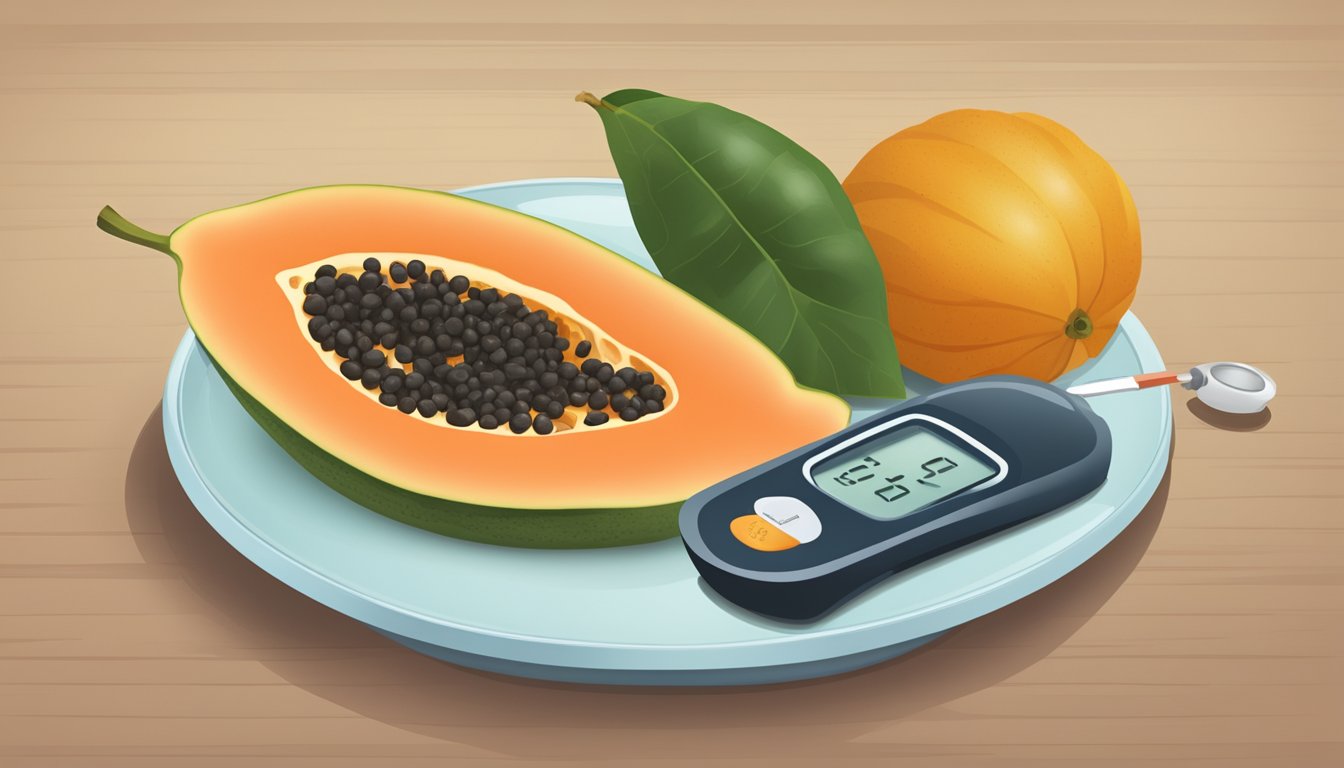
Incorporating papaya into a diabetic diet can be beneficial as it offers essential nutrients without causing significant spikes in blood sugar levels.
Health Benefits of Papaya
Papaya is beneficial for individuals with diabetes. It contains enzymes that may help in digestion and is a source of antioxidants. The fruit has a medium glycemic index (GI), which means it does not raise blood sugar levels rapidly.
- Vitamin Content: Rich in vitamin C and a source of vitamin A.
- Fiber: Contains 2.5 grams of fiber per cup, aiding in blood sugar control.
- Low-Calorie: A one-cup serving offers about 55 calories, making it suitable for weight management.
Health Benefits of Papaya for Diabetics:
| Nutrients | Benefits |
|---|---|
| Vitamin A | Supports vision and immunity |
| Vitamin C | Antioxidant, helps in healing |
| Fiber | Helps control blood sugar |
Consumption Recommendations
Papaya should be consumed in moderation by diabetics. Portion control is essential due to the natural sugars present in the fruit. A moderate amount can be easily integrated into the diet without leading to high blood sugar levels.
- Suggested serving size: 1 cup (cubed or sliced)
- Consider pairing with a protein or healthy fat to further stabilize blood sugar.
| Meal Ideas | Notes |
|---|---|
| Papaya Smoothie with Yogurt | Adds protein to help balance the meal |
| Fresh Papaya Salad | Combine with leafy greens for added fiber |
| Papaya with Cottage Cheese | Cottage cheese provides a source of healthy fat |
Remember, individual responses to carbohydrates can vary, so monitoring blood sugar levels after consuming papaya can help personalize dietary choices.
Balanced Diet and Diabetes
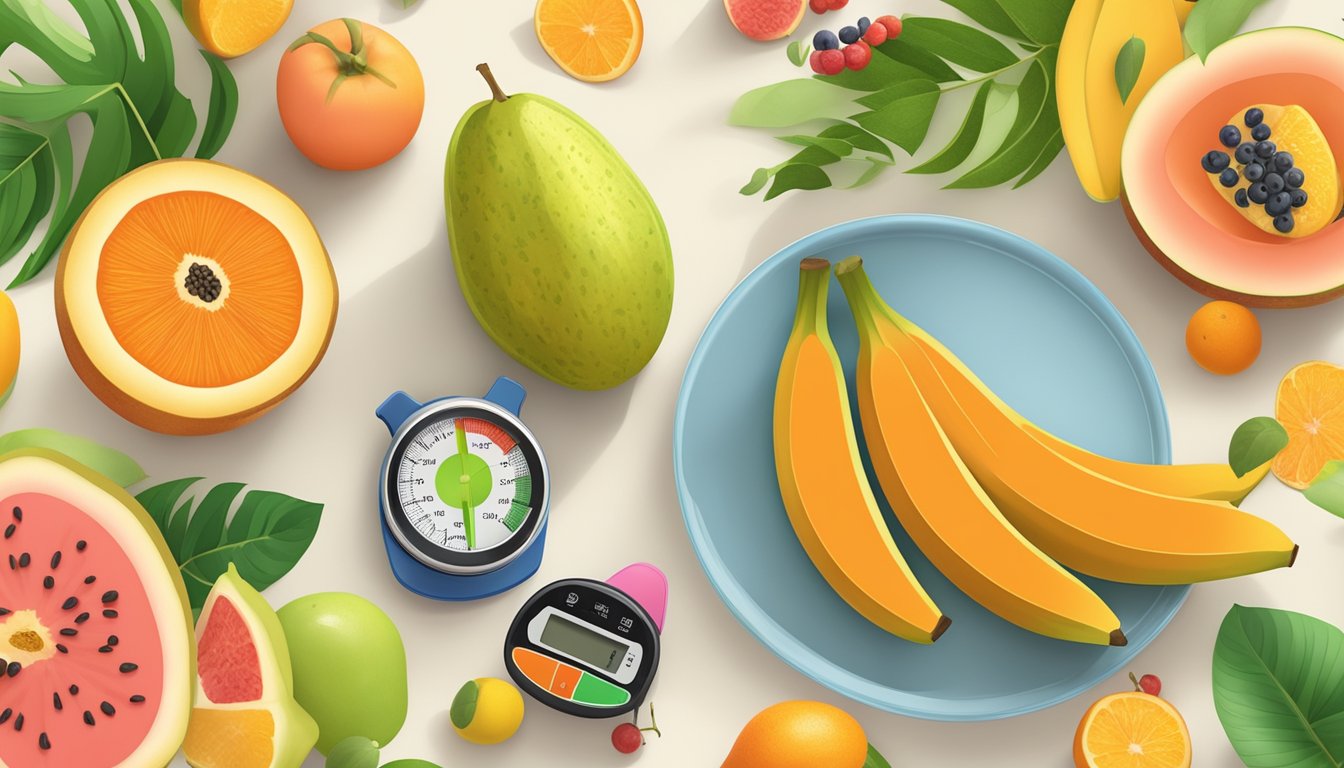
For individuals with diabetes, a balanced diet consisting of essential nutrients and controlled sugar intake is imperative for managing their condition effectively.
Incorporating Healthy Fats and Proteins
A balanced diet includes healthy fats and proteins. These macronutrients are crucial for maintaining stable blood sugar levels and providing sustained energy. Healthy fats, such as those found in avocados, nuts, and olive oil, are not only rich in energy but also come with many health benefits, including improved heart health due to their natural antioxidants and essential vitamins. Lean proteins like chicken, fish, and legumes are vital for muscle repair and can help regulate the body’s insulin response, making them a key component in a diabetic diet.
Example of Healthy Fats and Protein-rich Foods:
- Healthy Fats:
- Avocado
- Nuts (almonds, walnuts)
- Seeds (flaxseeds, chia seeds)
- Olive oil
- Proteins:
- Chicken breast
- Fish (salmon, mackerel)
- Legumes (lentils, chickpeas)
- Tofu
Avoiding Processed Snacks and Sugars
Minimizing processed snacks and sugars is essential. Processed foods are often high in added sugars and sodium, which can disrupt blood sugar control and lead to health complications. They usually lack the nutritional value found in whole foods, leading to poor dietary choices. Instead of reaching for processed snacks, individuals with diabetes should opt for whole, unprocessed foods that provide more nutritional benefits and help in maintaining a balanced diet, rich in vital nutrients like vitamin C and other natural antioxidants.
Alternatives to Processed Snacks:
- Fresh fruit (e.g., berries, apple slices)
- Raw veggies (e.g., carrot sticks, bell pepper)
- Nuts and seeds
- Whole grain crackers
By focusing on whole foods and nutrient-dense snacks, people with diabetes can enjoy a variety of delicious options that also contribute positively to their overall blood sugar management.
Is Papaya Beneficial for Diabetic Patients Managing Carbohydrate Intake?
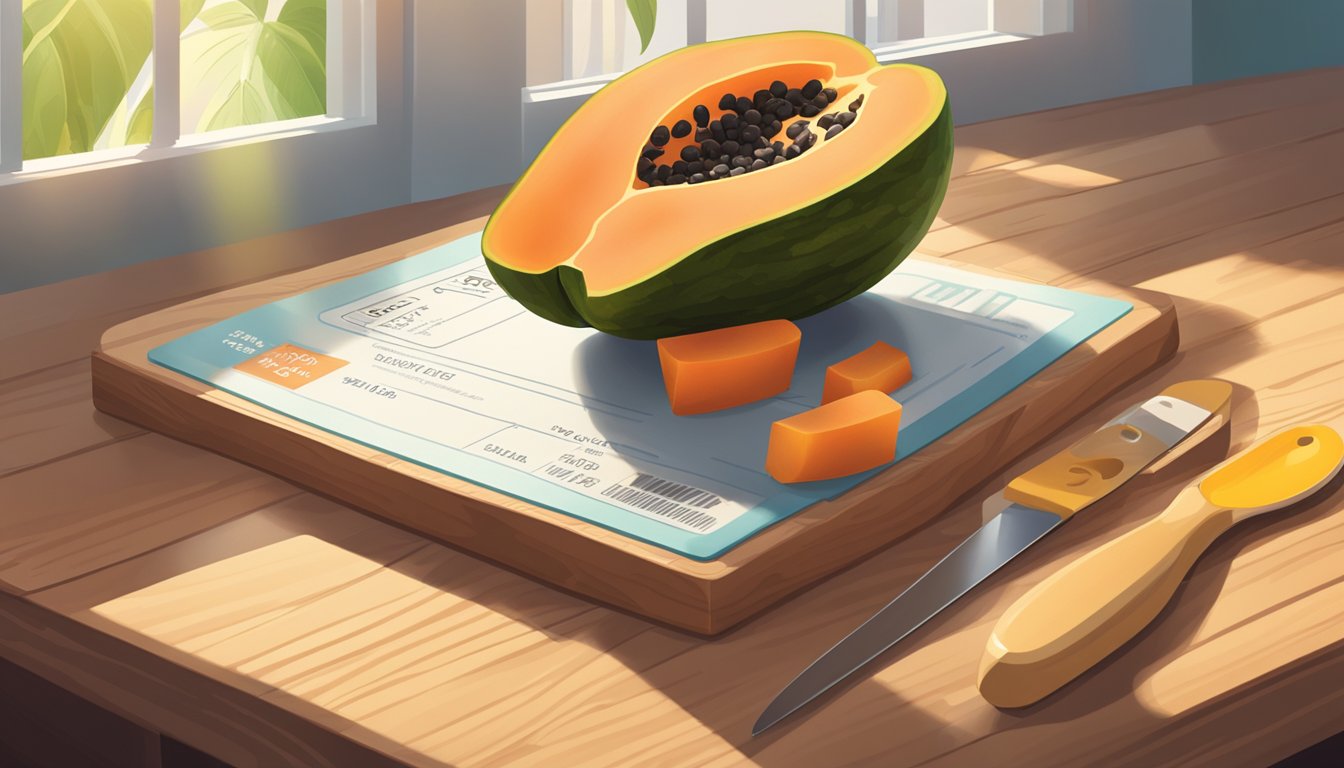
Papaya can be a suitable fruit for diabetic patients focusing on healthy eating and managing carbohydrate intake. When incorporating papaya into a daily diet, measuring carbohydrate portions is essential.
Carbohydrates are a major factor in blood sugar control. Here’s a breakdown of how to include papaya into a carbohydrate-managed diet:
Measure Portions:
- A medium-sized papaya contains about 15 grams of carbohydrates.
- Limiting the portion to half a medium papaya can keep carbohydrate intake in check.
Glycemic Index:
- Papaya has a medium Glycemic Index (GI), which means it has a moderate impact on blood sugar levels.
-
Nutritional Content of Papaya:
Nutrients Amount per Medium-sized Papaya Calories Approx. 119 kcal Fiber Approx. 3 grams Vitamin C 224% of the Daily Value Vitamin A 33% of the Daily Value Diet Integration:
- Diabetic patients should consider the total carbohydrate content of their meals, ensuring that papaya is included within these limits.
- Papaya can be a part of a well-balanced meal plan that promotes stable blood sugar levels due to its fiber content.
For diabetic patients, understanding the carbohydrate content of foods is vital to maintaining blood sugar levels. Papaya, when consumed in moderation, fits within the framework of a healthy diet and effective diabetes management.
Can Papaya Help in Blood Sugar Monitoring?
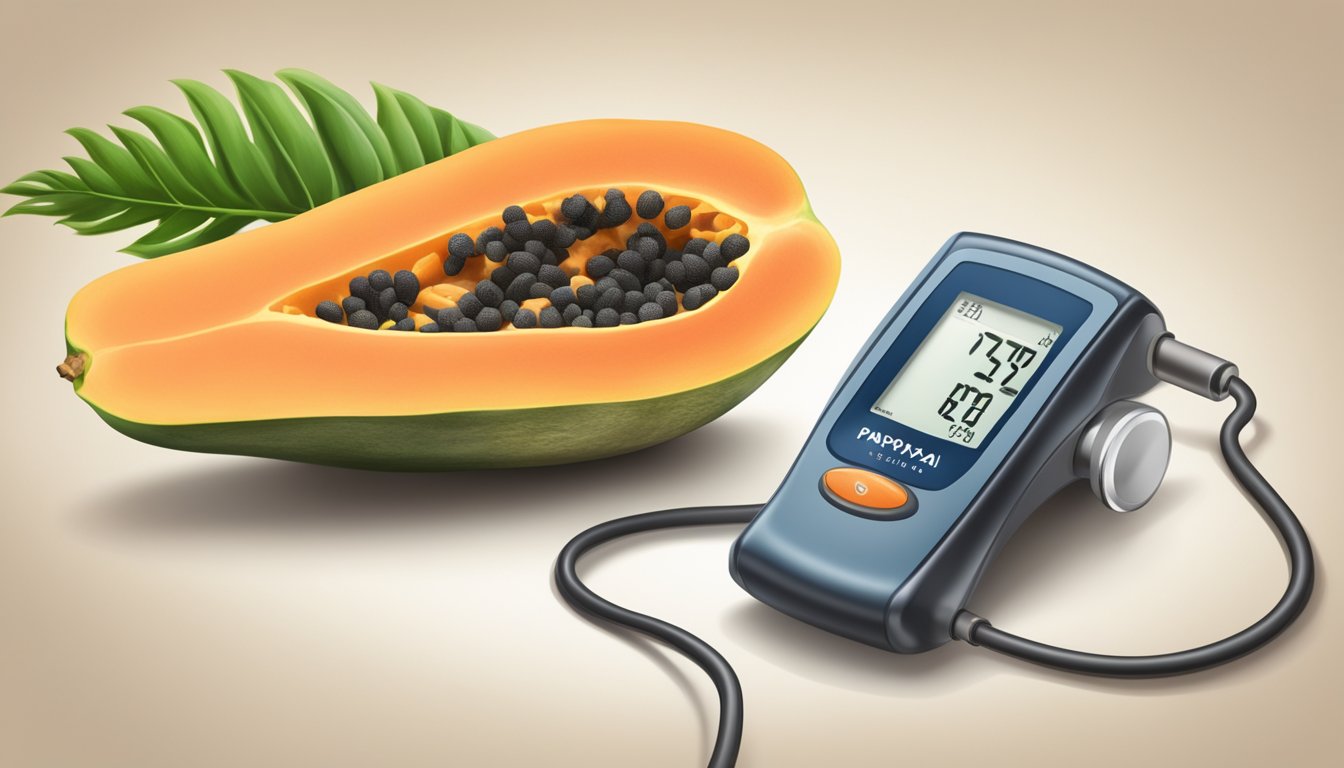
Papaya can be a helpful part of diet regulation for diabetics when it comes to monitoring and controlling blood sugar levels due to its medium glycemic index (GI).
Preventing Blood Sugar Spikes
Papaya should be included in a diabetic’s diet with mindfulness towards serving size to prevent blood sugar spikes. The medium GI of papaya implies that it does not cause rapid or high increases in blood sugar levels, which is crucial for individuals aiming to regulate blood sugar levels. Here are specific ways to avoid blood sugar spikes:
- Consuming papaya in moderation: No more than a small portion at a time to keep blood sugar within safe limits.
- Pairing with low GI foods: To maintain a balanced glycemic load during meals.
Adjusting Diet to Glycemic Response
Diabetics must adjust their diet to their individual glycemic response. Not all diabetics react the same way to certain fruits, and one’s blood sugar monitoring records will determine how much papaya can be consumed. Here is what must be considered:
| Factor | Strategy |
|---|---|
| Glycemic response | Monitor and record after eating papaya. |
| Portion sizes | Limit to small amounts if necessary. |
| Meal composition | Include protein and healthy fats with papaya. |
By closely monitoring blood sugar levels after eating papaya and adjusting dietary intake accordingly, diabetics can strategically include this nutrient-rich fruit in their meal plans.
Are Natural Sugars Different from Added Sugars?
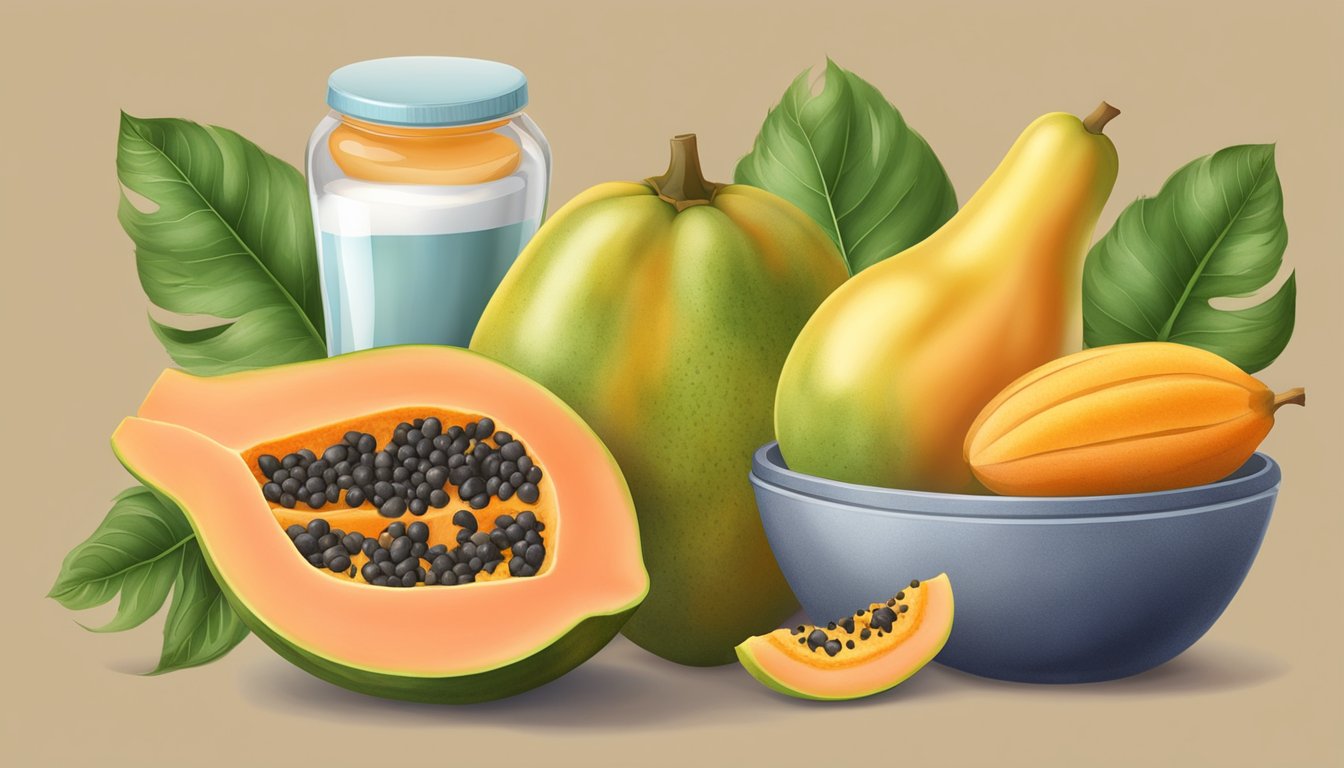
Yes, natural sugars and added sugars are distinct types of sugars that affect our bodies differently. Natural sugars are found inherently in foods such as fruits, including fresh papaya, and dairy products. These sugars come with additional nutrients like fiber, vitamins, and minerals. Added sugars, on the other hand, are those incorporated into foods and beverages during processing or preparation.
Natural Sugars in Fruit:
- Ripe papaya and other fruits contain natural sugars that provide energy.
- Natural sugars in fruits are accompanied by:
- Fiber: Slows down the absorption of sugar, aiding in blood sugar control.
- Vitamins: For instance, ripe papaya is a good source of vitamin C.
- Minerals: Like potassium, which is abundant in ripe papaya and supports heart health.
Added Sugars:
- Added sugars do not come with the beneficial nutrients that natural sugars in fruits provide.
- Common sources include:
- Sodas and sweetened beverages
- Candy
- Processed snacks
Sugar Content in Papaya:
- Fresh papaya contains sugar content that is naturally sweet and is considered a healthy fruit choice, especially for those monitoring their sugar intake, such as diabetics.
- The sugar in fresh papaya is different from added sugars because it’s part of a whole fruit package that offers health benefits.
Importance of Differentiation:
- Distinguishing between natural and added sugars is important for diabetes management.
- Consumption of healthy fruits like fresh papaya can be part of a balanced diet, providing essential nutrients without the spike in blood glucose associated with added sugars.
What Are the Nutritional Components of Papaya?
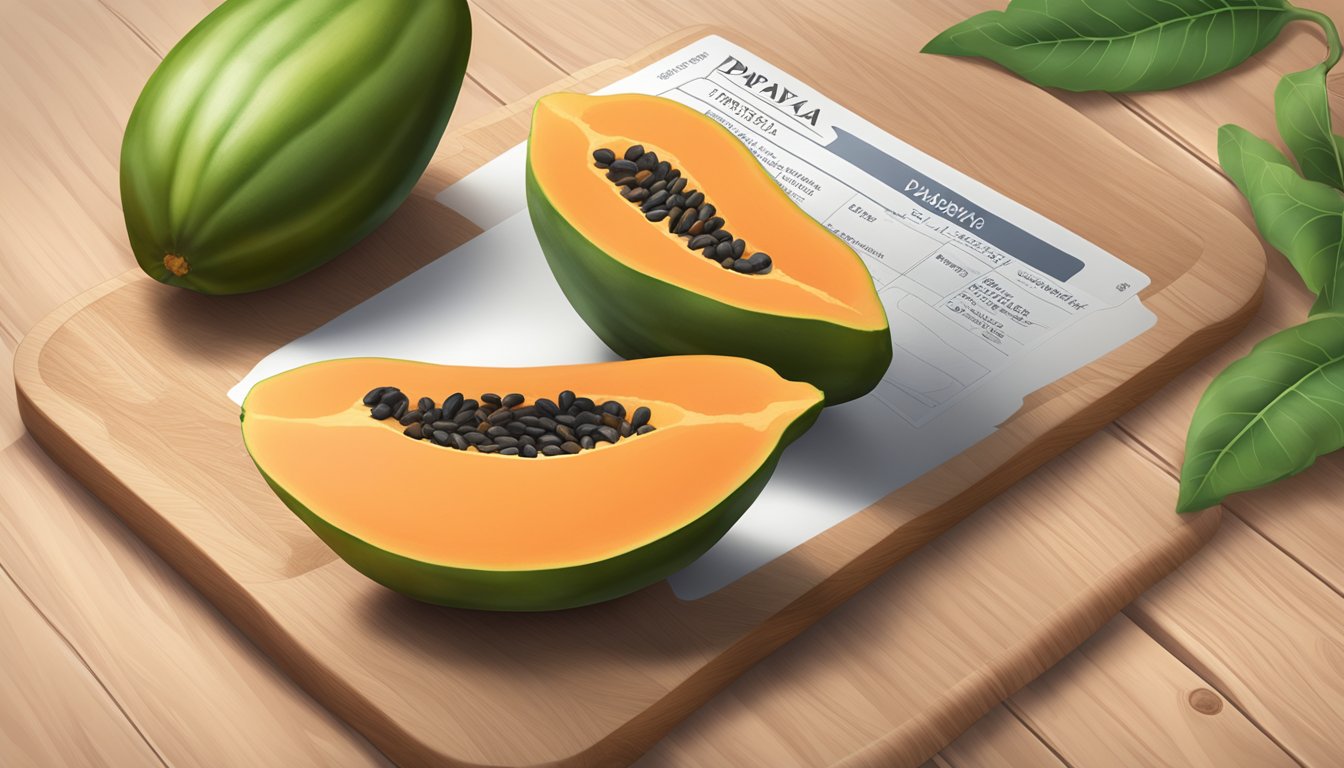
Papaya, regarded as a diabetes-friendly fruit, encompasses a range of nutrients beneficial for overall health.
Antioxidants and Vitamins
Papaya is rich in antioxidants and essential vitamins. It contains a significant amount of vitamin C, which is vital for immune function and skin health. Moreover, a small fresh papaya can provide more than the daily recommended value of this vitamin. Other nutrients include:
- Vitamin A: Important for vision and immune health.
- Beta-carotene: An antioxidant that converts to vitamin A in the body.
- Folate: Necessary for cell division and DNA synthesis.
| Nutrient | Importance |
|---|---|
| Vitamin C | Key for immune defense and skin health. |
| Vitamin A | Supports vision and immunity. |
| Beta-carotene | Antioxidant properties and vitamin A precursor to combat oxidation. |
| Folate | Essential for genetic material development and cell growth. |
Fiber and Hydration Content
A ripe papaya is not only hydrating but also a good source of dietary fiber. The water content in papaya aids in hydration, which is important for maintaining all bodily functions, including blood sugar regulation.
- Hydration: Papayas have a high water content, aiding in hydration and potential diabetic blood sugar control.
- Fiber: One small fresh papaya contains about 3 grams of dietary fiber, beneficial for blood glucose control and digestive health.
Bullet points regarding Fiber and Hydration Content:
- A small fresh papaya can be a source of hydration due to its water content.
- Dietary fiber in papaya helps in slow digestion and glucose absorption, which may aid in blood sugar regulation.
Health Complications and Dietary Considerations
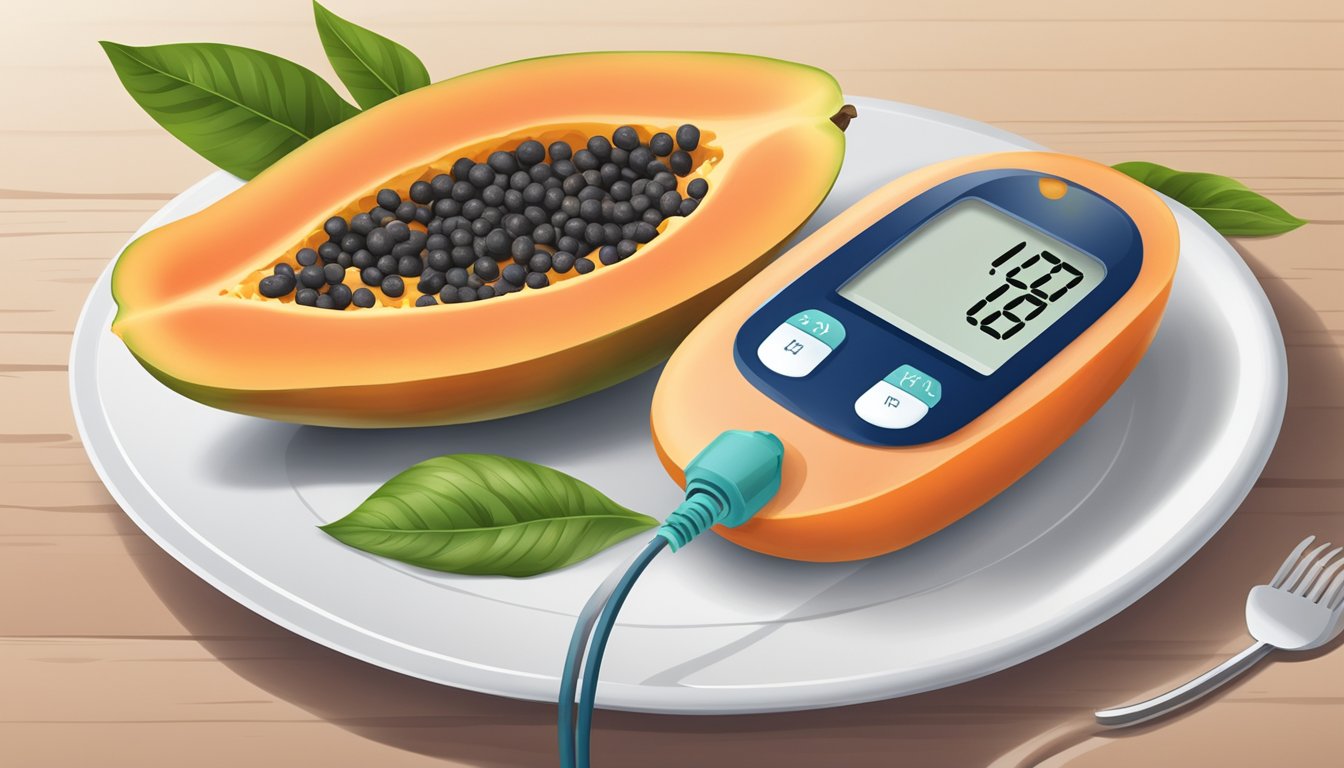
Managing diabetes effectively involves understanding the impact of foods on blood sugar levels while considering their influence on diabetes-related complications, such as cardiovascular and kidney damage, as well as nerve issues. Careful dietary choices can mitigate these risks.
Can Papaya Prevent Cardiovascular and Kidney Damage?
Papaya can play a role in preventing heart disease and kidney damage. This fruit, with its rich nutritional profile, includes antioxidants which help reduce oxidative stress, a factor implicated in cardiovascular disease. Furthermore, the potassium found in papaya can aid in blood pressure regulation, reducing strain on the cardiovascular system.
Potassium Content and Cardiovascular Health:
- Helps to lower blood pressure
- Reduces the risk of stroke
Antioxidant Properties and Kidney Health:
- Minimizes oxidative stress
- May protect against kidney damage
| Nutrient | Benefit |
|---|---|
| Vitamin C | Supports immune function, which can be compromised in kidney disease. |
| Fiber | Aids in controlling high blood sugar by slowing glucose absorption. |
How Does Papaya Assist in Dealing With Diabetes-Related Nervous Conditions?
The consumption of papaya may assist in reducing nerve damage associated with diabetes complications. The vitamins and minerals in papaya support nervous system health, while its low glycemic index means that it does not cause a rapid spike in blood sugar levels.
Vitamin B and Nerve Function:
- Nourishes the nervous tissue
- Helps prevent neuropathy, a common diabetes complication
Glycemic Index and Blood Sugar Control:
- Medium GI fruit
- Contributes to steady blood sugar levels, important in diabetes nerve complications management
By incorporating papaya into a diabetic diet, individuals may find it beneficial in addressing not only direct diabetes management through blood sugar control but also in preventing or managing some of the secondary health complications commonly observed in diabetes, such as cardiovascular and kidney damage and diabetes-related nerve damage.
Should Diabetic Patients Consult Healthcare Professionals?

Yes, diabetic patients should consult healthcare professionals to manage their condition effectively. These professionals are equipped to provide personalized advice that can help in adjusting dietary choices, including the consumption of papaya, and in monitoring the impact on blood sugar levels and insulin sensitivity.
Importance of Professional Guidance
- Tailored Dietary Plans: Healthcare providers can develop individualized meal plans that optimize nutrient intake and sugar balance.
- Monitoring and Adjustments: Regular check-ups enable timely tweaks to treatment plans based on glucose monitoring results.
- Education: Patients receive education about the disease process and how different foods, like papaya, may affect their blood sugar levels.
Factors to Discuss with a Healthcare Provider
- Blood Sugar Control: How papaya consumption could influence blood glucose levels.
- Insulin Sensitivity: Potential effects of papaya on the body’s response to insulin.
- Medication Interactions: If and how papaya might interact with diabetes medications.
Table: Nutritional Aspects of Papaya to Discuss
| Aspect | Why It Matters |
|---|---|
| Low Glycemic Index | May help moderate blood sugar rise |
| Fiber Content | Could aid in improving glucose control and insulin sensitivity |
| Antioxidant Profile | Might reduce oxidative stress and inflammation, often increased in diabetes |
Healthcare professionals serve as essential partners for people with diabetes in managing their condition. Their expertise and support are pivotal in making informed decisions about including papaya or any other food in a diabetic diet.
Frequently Asked Questions

The following addresses common inquiries regarding papaya consumption for individuals with diabetes, covering impacts on blood sugar levels, glycemic index, health benefits, recommended quantities, and comparisons with other fruits.
Can diabetics consume papaya without increasing their blood sugar levels?
Yes, they can, as papaya has a medium glycemic index and may be consumed in moderation. Some studies suggest that papaya could have a hypoglycemic effect, potentially lowering blood sugar levels.
What is the glycemic index of papaya, and how does it affect diabetes management?
Papaya has a medium glycemic index (GI), generally ranging from 56 to 59. Foods with a medium GI are slower to raise blood sugar levels, which is beneficial for diabetes management.
Are there benefits to eating papaya for diabetes complications like kidney health?
Papaya can be beneficial for diabetes-related complications as it is high in fiber and contains antioxidants like vitamins C and E, which support kidney health.
| Benefits of Papaya | Explanation |
|---|---|
| High Fiber Content | Aids in blood sugar regulation |
| Antioxidant-Rich | Potentially protects against kidney damage |
| Vitamin C and E | Supports overall kidney function |
What quantity of papaya is recommended for diabetic patients?
Diabetic patients should consume papaya in moderation. While specific quantities may vary by individual dietary needs, a small to medium-sized portion can be part of a diabetic diet.
How does papaya’s sugar content compare to other fruits for diabetic diets?
Papaya’s sugar content is relatively high, but it also contains fiber, which helps mitigate the blood sugar response. Compared to other fruits, it should be eaten in careful moderation.
| Fruit | Sugar Content | Fiber Content |
|---|---|---|
| Papaya | Higher sugar (11g per medium) | High fiber |
| Berries | Lower sugar | Comparable fiber |
| Apples | Moderate sugar | High fiber |
Which fruits are considered the best options for individuals managing diabetes?
Berries, cherries, and apples are some of the best options for individuals with diabetes due to their lower glycemic index and high fiber content.
- Berries: Low GI, high fiber
- Cherries: Low GI
- Apples: Moderate GI, high in fiber
